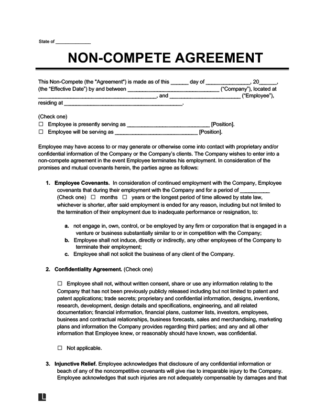
Use our non-compete agreement to prevent a person or business from competing with your company.

Updated August 27, 2024
Written by Josh Sainsbury | Reviewed by Brooke Davis
A non-compete agreement is a contract employers use when hiring an employee to prevent the employee from working in the same industry as another party. It can also be useful when dissolving a partnership or selling a business.
The author of a non-compete agreement must draft it according to state laws and ensure it contains reasonable provisions.
In a significant legal development, the Federal Trade Commission’s (FTC) Final Rule aimed at prohibiting most non-compete agreements was struck down by a Texas federal district court before its scheduled effective date of September 4, 2024. Here’s what you need to know:
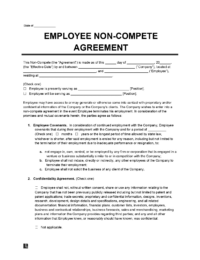
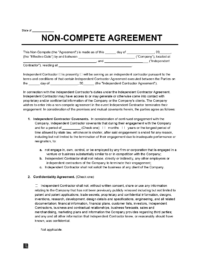
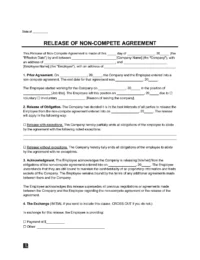
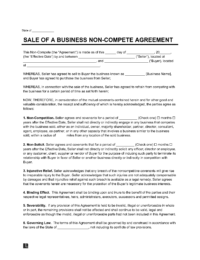
A non-compete agreement is a legal document that restricts one party from competing with another in the same industry or geographical area. For example, consider a software development company that hires John as a senior developer. During his employment, John gains access to proprietary software code and client lists that give the business a competitive edge in the industry.
Upon hiring, John signs a non-compete agreement that prohibits him from joining a rival tech firm or starting his own competing business for one year after leaving the company. This agreement helps ensure that John cannot use the sensitive information he acquired to undermine the tech firm’s market position.
An alternative to non-compete agreements is to include a non-compete clause in a legally binding employment contract or confidentiality agreement form.
Here are the requirements for a non-compete agreement:
This agreement goes into effect once the employee or contractor severs ties with the company. There are a few ways that a company can draw up non-compete agreements and a few scenarios in which they would be helpful:
For example, David, the owner of a successful coffee shop chain, decides to sell his business to a larger competitor, BrewMasters Inc. As part of the sale, David agrees to a non-compete clause that prohibits him from opening a new coffee shop within a 100-mile radius for three years.
This clause protects BrewMasters from immediate competition by ensuring that David, with his industry experience and customer base, does not start a new venture that could draw away customers from the business he just sold.
Employees are valuable components of your company. Depending on the level and specialization of the employee, they often know your business and industry intricately. This knowledge helps them make your company successful. But given to a competing entity, it could be a distinct disadvantage to your organization.
Without a non-compete agreement, a key employee could leave and would likely stay in the area and the same industry. While companies can’t stop employees from moving on or working in the field, they also shouldn’t risk intellectual property or insider knowledge being used against them.
Here are some possible outcomes without this agreement in place:
Here’s a list of steps you can follow to create a non-compete agreement:
Check your state’s laws, but keep in mind that the FTC’s Final Rule now sets federal standards that may supersede state laws. Ensure your agreement complies with both state regulations and the new federal rules.
Since most non-compete agreements are now prohibited, confirm whether your agreement is applicable. It may still be valid for senior executives or in the context of the sale of a business.
If creating a permissible non-compete, clearly define the scope of restricted activities and establish a reasonable duration. Be aware that the FTC’s Final Rule limits the use of non-competes, particularly regarding duration and scope.
Given the restrictions on non-competes, you might want to focus on drafting non-disclosure and non-solicitation agreements to protect your business interests. These can be effective substitutes in most cases where non-competes are no longer allowed.
Once your agreement is drafted and complies with applicable laws, ensure it is signed by all relevant parties. This includes obtaining signatures from the parties to be bound by the agreement.
An employee can challenge a non-compete agreement in court for the following reasons:
Review an example of our non-compete agreement template. Download it as a PDF or Word file below: